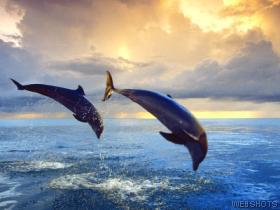|

Whales, dolphins and porpoises belong to the family of marine mammals known as cetaceans. Unlike fish, cetaceans are mammals.
This means they are air-breathing, warm-blooded, bear live young and nurse them on milk Cetaceans play an important role in
the life of the ocean, serving as flagships for the health and well-being of the whole marine ecosystem.
Completely adapted to life in the water, whales breathe through blowholes on top of their heads. This way they can breathe
and keep swimming at the same time. Unlike fish, which swish their tails from side to side, whales swim by pumping their tails
vertically, and using their flippers to steer.
Dolphins rely on sound production and reception to navigate, communicate, and hunt in dark or murky waters. Under these
conditions, sight is of little use. A mother dolphin may whistle to her calf almost continuously for several days after giving
birth. This acoustic imprinting helps the calf learn to identify its mother.
Unlike whales and dolphins, porpoises are quite secretive and seem to be weary of boats. Because of this shy personality,
most types of porpoises are not often observed in the wild. In fact, the blow, a cloud of moisture rich air expelled through
the blowhole, is rarely seen or photographed
Along with hunting, collisions with ships, and the degradation of their habitat due to pollution, the greatest threat
to whales, dolphins and porpoises is entanglement in fishing gear, also known as bycatch. If current trends continue unabated,
several cetacean species and many populations will be lost in the next few decades.
Crystal
|
|
Additional Information: A million or more dolphins and porpoises of many species are dying each year in nets.
The culprit is the gill net, a simple contrivance of twine and knots known since ancient times. Fish poke their heads
through the mesh and become entangled by their gills as they attempt to withdraw. Dolphins meet the same fate when they hook
teeth, beaks, or fins in the mesh and quickly drown.
Species such as porpoises are especially hard hit, and some are in serious decline. Colonies of seabirds too have crashed
precipitously, when birds were snagged by gill-net fleets far offshore.
In seining, dolphin schools are actively sought by fishermen because they are beacons for the tuna that often swim beneath
them. Tuna tend to congregate beneath surface objects, and scientists speculate that traveling with a dolphin school may help
the tuna locate food as well as give them protection from predators.
The fishermen circle both dolphins and tuna with a mile-long, curtain-like net, close off the net bottom to form a teacup
shape, then attempt to separate fish from mammals, an imperfect maneuver in which thousands of dolphins die each year.
© 1993-2003 Microsoft Corporation. All rights reserved.
Back to Endangered Animals
Back to Running Wild
|



